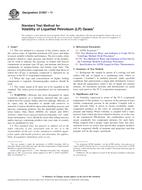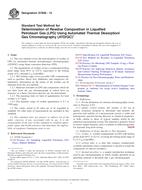Potrebujeme váš súhlas na využitie jednotlivých dát, aby sa vám okrem iného mohli ukazovať informácie týkajúce sa vašich záujmov. Súhlas udelíte kliknutím na tlačidlo „OK“.
ASTM D1837-11
Standard Test Method for Volatility of Liquefied Petroleum (LP) Gases
Automaticky preložený názov:
Štandardná skúšobná metóda pre výpočet volatility skvapalnených ropných plynov (LP)
NORMA vydaná dňa 1.10.2011
Informácie o norme:
Označenie normy: ASTM D1837-11
Poznámka: NEPLATNÁ
Dátum vydania normy: 1.10.2011
Kód tovaru: NS-18529
Počet strán: 4
Približná hmotnosť: 12 g (0.03 libier)
Krajina: Americká technická norma
Kategória: Technické normy ASTM
Kategórie - podobné normy:
Anotácia textu normy ASTM D1837-11 :
Keywords:
butane, liquefied petroleum (LP) gases, LPG, propane, volatility, ICS Number Code 75.160.30 (Gaseous fuels)
Doplňujúce informácie
| Significance and Use | ||||||
|
Volatility, expressed in terms of the 95 % evaporated temperature of the product, is a measure of the amount of least volatile components present in the product. Coupled with a vapor pressure limit, it serves to ensure essentially single-component products in the cases of commercial grades of propane and butane. When volatility is coupled with a vapor pressure limit which has been related to density, as in the case of the commercial PB-mixture, the combination serves to assure essentially two component mixtures for such fuels. When coupled with a proper vapor pressure limit, this measurement serves to assure that special-duty propane products will be composed chiefly of propane and propylene and that propane will be the major constituent. |
||||||
| 1. Scope | ||||||
|
1.1 This test method is a measure of the relative purity of the various types of liquefied petroleum (LP) gases and helps to ensure suitable volatility performance. The test results, when properly related to vapor pressure and density of the product, can be used to indicate the presence of butane and heavier components in propane type LP-gas, and pentane and heavier components in propane-butane and butane type fuels. The presence of hydrocarbon compounds less volatile than those of which the LP-gas is primarily composed is indicated by an increase in the 95 % evaporated temperature. 1.2 When the type and concentration of higher boiling components is required, chromatographic analysis should be used. 1.3 The values stated in SI units are to be regarded as the standard. The values given in parentheses are for information only. 1.4 WARNINGMercury has been designated by many regulatory agencies as a hazardous material that can cause central nervous system, kidney and liver damage. Mercury, or its vapor, may be hazardous to health and corrosive to materials. Caution should be taken when handling mercury and mercury containing products. See the applicable product Material Safety Data Sheet (MSDS) for details and EPA’s websitehttp://www.epa.gov/mercury/faq.htmfor additional information. Users should be aware that selling mercury and/or mercury containing products into your state or country may be prohibited by law. 1.5 This standard does not purport to address all of the safety concerns, if any, associated with its use. It is the responsibility of the user of this standard to establish appropriate safety and health practices and determine the applicability of regulatory limitations prior to use. |
||||||
| 2. Referenced Documents | ||||||
|
Podobné normy:
Historická
15.4.2009
Historická
1.6.2009
Historická
1.6.2014
Historická
1.10.2013
Historická
15.6.2013
Historická
1.11.2012



 ASTM D6897-09
ASTM D6897-09 ASTM D6968-03(2009)..
ASTM D6968-03(2009).. ASTM D7493-14
ASTM D7493-14 ASTM D7607/D7607M-11..
ASTM D7607/D7607M-11.. ASTM D7756-13
ASTM D7756-13 ASTM D7828-12
ASTM D7828-12
 Cookies
Cookies
